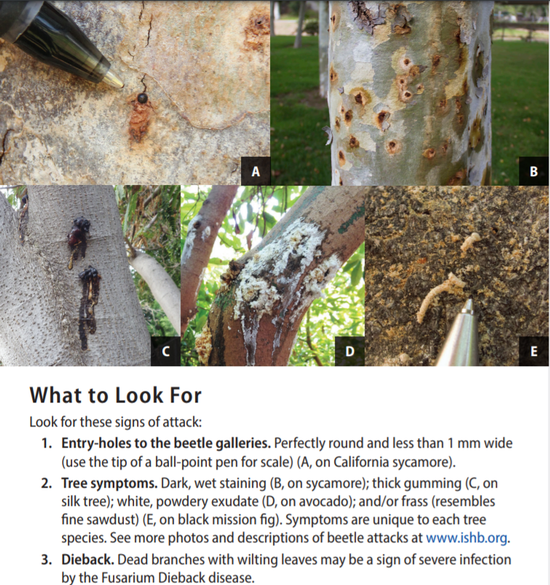Invasive Shot Hole Borer
We're working with the Santa Barbara County Agricultural Commissioner to monitor the spread of ISHB.
We ask for your help in sending us possible Invasive Shot Hole Borer infestations.
Information on how to assess and report possible infestations is at the bottom of this page.
What Is ISHB? ¿Qué es ISHB?
- Invasive shot hole borers (ISHB) (Euwallacea spp.) are two species of genetically distinct, but physically identical, non-native beetles: Polyphagous shothole borer (PSHB) and Kuroshio shothole borer (KSHB).
- These small beetles bore into trees and spread a disease called Fusarium dieback (FD).
- The ISHB-FD pest-disease complex is responsible for the death of thousands of trees in Southern California and poses an imminent threat to the integrity of our urban and natural forests.
- Invasive shot hole borers attack a wide variety of tree species including avocados, common landscape selections, and California native species in urban and wildland environments.
ISHB in Santa Barbara County
Invasive shot hole borers and Fusarium dieback were found in oak and sycamore trees in Montecito in 2017.
Stop the Spread of ISHB-FD
- Don't move firewood!
Many wood-boring pests, including ISHB, are spread by the transport of infested wood. Buy firewood where you intend to burn it. Visit dontmovefirewood.org and www.firewood.ca.gov for additional resources and information that you can share with others.
-
Properly dispose of infested material
Do not use untreated ISHB-infested logs or chips for firewood or mulch. Options for treating infested material include solarization, composting, kiln-drying, and biogeneration. Learn more about these options here. -
Disinfect pruning tools
Poor pruning practices can facilitate the spread of plant disease. Any pruning, sampling, or other tools that come into contact with infected wood should be sanitized before being used on uninfected trees. This includes chainsaws and wood chipping equipment. If several infested and uninfested trees need to be maintained on a property, we recommend managing the trees in batches. First take care of all of the uninfested trees, then move to the infested trees so that your tools won't need to be cleaned until the end of the day.
For pruning and tool sterilization tips, see UC Riverside's "Best Management Practices for Disease in Oak Woodlands" .
What to Look For
ISHB beetles are so small they are hard to see. They create round holes the size of a ballpoint pen's tip. Different tree species react differently (like staining, gumming, frass, or white powdery exudate on bark).
ISHB infests and harms over 65 tree species. If you think you know the name of the tree you're concerned about, you can look for it on this list.
Symptoms can vary between tree species. See the photo below for examples.
Some tree species have pests that leave look-alike symptoms. See below for examples.
Video Resources
Learn more by watching videos:
- Invasive Shot Hole Borers-Informative Video (8 minutes, from the Santa Barbara County Agricultural Commissioner)
- Monitoring and Sampling Trees for Invasive Shot Hole Borers (under 3 minutes, from UC IPM)
- Santa Barbara County ISHB Zoom meeting (1 hour 40 minutes, October 2021, from state, UC, and Santa Barbara County experts)
ISHB Look-Alikes
Other pests cause similar symptoms in these trees:
- Avocado (Look-alikes: Xyleborinus saxeseni and Xanthomonas campestris)
- Coast Live Oak (Look-alikes: Western oak bark beetle and Foamy bark canker, Monarthrum oak ambrosia beetles, Western sycamore borer, and Gold-spotted oak borer)
- Stonefruit (Prunus spp., like plum, peach, cherry, and apricot) (Look-alikes: Fruit tree bark beetle)
- Sycamore species (Look-alikes: Western sycamore borer)
If you think a tree in Santa Barbara County has ISHB:
- Look for round entry holes in the trunk and/or branches. ISHB holes are the size of a ballpoint pen tip. You might need to scrape off material away from the hole in order to see the size and shape of the hole. See the photos below for examples.
- If you know what kind of tree it is, check it against the list of known ISHB tree hosts.
- Is your tree known to have "look-alike" pests? (Avocado, Coast Live Oak, Stonefruit, Sycamore)
- If your tree is on the list, look for brown stains in the wood (under the bark) around the entry hole.
- Take pictures of:
- the tree
- affected tree parts, including any material surrounding the hole
- the hole itself (with a ballpoint pen tip beside it for scale)
- any staining in the wood, under the bark
- Send your contact info, the photos, the tree name, and the tree location to our Home Gardening Helpline (anrmgsb@ucanr.edu).
For more information, see UCANR publication 240640 (on Invasive Shot Hole Borer)



